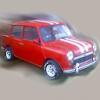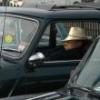Hi good people of TMF

This is just an update on the digital tachometer design progress. I will describe my design ideas and would like some constructive critism. Thanks to all for their responses.
Doug I have considered using the mentioned LM2917 IC however I have decided against using it for my main design reasons that follow.
The LM2917 is a frequency to voltage converter; in a nutshell it outputs a DC voltage proportional to the input frequency. This output voltage is analogue and is thus extremely hard to convert to a format displayable on 7-Segment LEDs without employing the use of a microprocessor chip (PIC or the likes)
SO...
I have decided to follow 2 routes:
1 - A simple design based using the LM2917 and a PIC microcontroller for conversion to Binary Coded Decimal (BCD) format that can be displayed on four 7-seg LEDs. I will make the code available and final circuit schematics.
Now I understand that some of us have no experience using/programming microcontrollers, for this reason my second design will use basic IC`s available at any electronics store. All that will need to be done is a bit of soldering.
2 - Let me see if I can explain this correctly.
Theory of operation is to count how many pulses of a certain set frequency that can fit into the period of one engine revolution.
Four BCD counters will be cascaded ... this will enable the display to the 7 seg LEDs via a latch.
I will use a 555 timer (or the likes) to generate a high frequency
continuous pulse train, this pulse train will increment the counters mentioned above.
A second counter will be used to count the amount of sparks occurring by using the (-)ve terminal of the coil as a signal. Once
four sparks have occurred (all cylinders have fired) I will use this counter to do the following:
- Reset itself
- Latch the counted value to the 7 Seg display
- reset the 4 BCD counters
Its a bit vague

but will get something working soon.



















